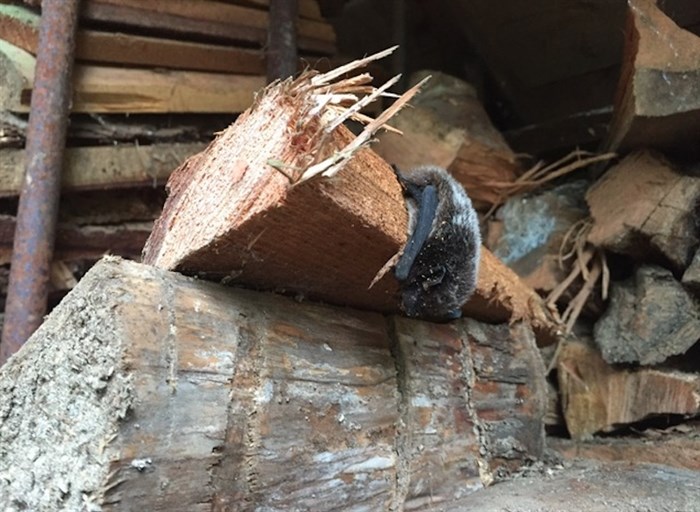
This Little Brown Bat has the fungus responsible for white-nose syndrome, and will likely die as the species faces a 100 per cent mortality rate for the disease.
Image Credit: SUBMITTED / B.C. Community Bat Program
February 05, 2020 - 6:00 PM
White Nose Syndrome is a fungal disease that has wiped out millions of bats across North America, and it may make its way to B.C. next.
White-nose syndrome has been reported just 150 kilometres from the B.C. and United States border, on the east and west sides of the Cascade Mountains in Washington. The disease has a 100 per cent mortality rate for some of the species it impacts, such as the Little Brown Bat, and has no known cure, according to the B.C. Community Bat Program.
In the Thompson-Okanagan, bat researchers and scientists are working against the clock to create a vaccine to prevent bats from getting the disease. The disease always takes hold in the cold months, and although bats normally only wake up a few times during hibernation, bats with white-nose syndrome will wake up regularly to warm up in hopes of kicking their immune system into high gear. If they haven’t died of exhaustion, the fungus eats away at their tissue and can leave holes in their wings come springtime, leaving them unable to fly and hunt, according to Cori Lausen, associate research biologist with the Wildlife Conservation Society Canada.
The B.C. Community Bat Program is asking for the public’s help in getting a better understanding of the province’s bat population so they can monitor the potential spread of the disease, and work to keep populations healthy. Signs of the disease include seeing dead bats and unusual bat activity during winter. Reporting winter bat activity will help the organization focus its research, monitoring and protection efforts.
Although bats normally hibernate out of sight during the winter months, if you see one sleeping by itself, the B.C. Community Bat Program asks you to snap a photo and report it. Some bats may wake up during the warmer winter days to hunt and drink, but the organization still asks for sightings to be reported.

Bats may hibernate in woodpiles. If you spot on, snap a photo and report it to the B.C. Community Bat Program.
Image Credit: SUBMITTED / B.C. Community Bat Program
“We are encouraging the public to report dead bats or any sightings of winter bat activity to the B.C. Community Bat Program,” says Rodriguez de la Vega, the Okanagan coordinator with the B.C. Community Bat Program in a media release. “Bat carcasses will be submitted for testing for white-nose syndrome and would provide the earliest indication of the presence of the disease in B.C.”
If you see a bat, dead or alive, don’t touch it with your bare hands. If you or your pet has come in contact with the dead animal, you will need to look into the possibility that rabies may have been passed along from the bat.
The B.C. Community Bat Program is funded by the Habitat Conservation Trust Foundation, the Forest Enhancement Society of B.C., the Province of B.C., the Habitat Stewardship Program and the South Okanagan Conservation Fund, and works alongside the government on public outreach and education.
If you have a bat sighting or a dead bat to report, contact the B.C. Community Bat Program by visiting their website, sending an email, or calling 1-855-922-2287 ext. 13.
To contact a reporter for this story, email Jenna Wheeler or call (250) 819-6089 or email the editor. You can also submit photos, videos or news tips to the newsroom and be entered to win a monthly prize draw.
We welcome your comments and opinions on our stories but play nice. We won't censor or delete comments unless they contain off-topic statements or links, unnecessary vulgarity, false facts, spam or obviously fake profiles. If you have any concerns about what you see in comments, email the editor in the link above.
News from © iNFOnews, 2020